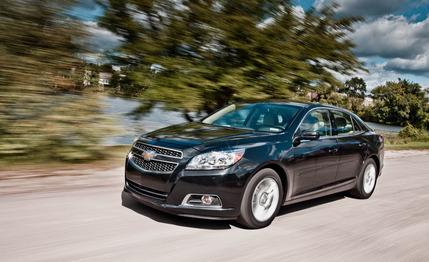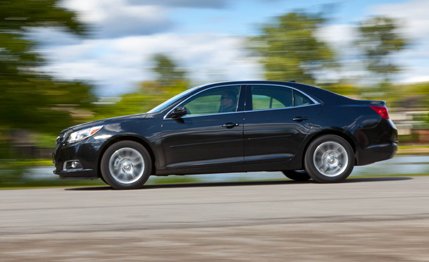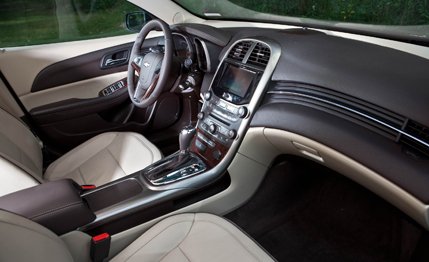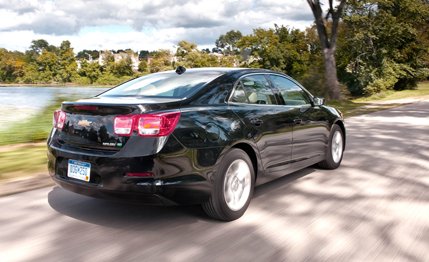
 Prototype Drive
Prototype Drive
Hard to believe, but what we have here is the eighth-generation Malibu, a car on sale 35 years and, uh, spanning six decades. It has historically been a kind of peripatetic approximation of Midwestern mobile civility—here today, gone tomorrow, then suddenly back again—and it was surely facing another passenger-pigeon demise when GM startlingly imbued the Malibu with all of the stellar credentials found in its sister, the Saturn Aura. Faster than we could say, “GM did what?” the previous-gen Malibu landed on our 2008 10Best list.
The first of the brand-new Malibus, slated to appear in the spring of 2012, is the Eco, featuring GM’s “light electrification of a traditional powertrain,” a.k.a. eAssist. GM doesn’t want us calling it a hybrid, although “hybrid” sure rolls off the tongue easier than “light electrification.” The system includes an all-in-one motor/generator that replaces the alternator, connected to 32 lithium-ion cells jammed into a 65-pound battery pack located aft of the rear seat. Via a rubber belt, the electric motor/generator—built in China, with no permanent magnets—contributes a bonus 15 horses to the crankshaft, mostly under wide-open throttle. Fun fact: The belt has a duty life of 75,000 miles. The Eco’s gas engine displaces 2.4 liters and produces 182 horsepower. Combined, engine and motor are expected to deliver 26 mpg in the city and 38 on the highway. We shall see.
Next summer, the more traditional gas-only Malibus will arrive—LS, LT, and LTZ—and they’ll all be powered by a brand-new 2.5-liter Ecotec producing an estimated 190 ponies. If so, that’s a healthy 21-hp nudge beyond the Malibu’s existing inline-four. By the way, GM is so certain you’re freaked out over fuel prices that no V-6 will be offered. That’s a bold wager.


We didn’t drive a Malibu with the new engine. It wasn’t ready. Nor was GM positive about its power output. Nor of its fuel economy, although “more than 30 mpg highway” was a stated goal. Instead, what we drove was a preproduction Malibu Eco with 17-inch tires and an LTZ-level cabin that wasn’t finished. Price? GM didn’t know that, either. Hey, sometimes you make the trailer for a movie before you make the movie, okay?
The Malibu’s upscale cabin remains upscale, awash in contrasting colors and classy stitching, as well as so-called basketball graining, which sounds awful but contributes to dimension and depth. So, too, do new decorative lateral dashboard “vanes” that glow with ice-blue ambient lighting. The radio’s touch screen cleverly flips up to reveal a six-inch-deep bin that’s big enough to swallow a cell phone and abag of Fritos. The front seat cushions are firm and nicely scalloped. For two folks, back-seat comfort is excellent, with the Malibu’s wider front and rear tracks resulting in a 3.2-inch gain in shoulder room.
On GM’s ride-and-handling track in Milford, Michigan, what we first noticed is that the new Malibu is extraordinarily quiet, that its structure feels even more solid than before, and that you can’t feel the electric motor kicking on or off. The ride is firm but appropriate to the market, and body motions are adequately damped. At light throttle, there’s no telling how many cylinders are at play. At rest, there are supposed to be zero cylinders at play, thanks to the automatic stop-start function, but our test car never turned itself off. Under WOT, the Ecotec still evinces a high-frequency thrum that lays bare its humble four-ishness, and it will be thrumming aplenty because this new Malibu feels heavy, asking for a lot of throttle to get out of the blocks. How heavy? GM doesn’t know that, either. Or at least isn’t telling. The car certainly feels no quicker to 60 mph than the 8.7 seconds required for the Malibu LT we sampled in March 2008. Anyone yet pining for the abandoned V-6’s 252 horses?


The Malibu’s ZF electrically assisted power steering is low on feedback, but the weighting is fine and so is tracking. Here’s good news: The regenerative braking that helps charge the batteries reveals itself not at all in pedal feel. No pulses, no soft spots—just firm, linear travel. Here’s bad news: The battery pack rests between the rear wheel wells and is cooled by a fan in the rear parcel shelf. It draws air from the cockpit. What with all of its tubes and snorkels, the thing reduces trunk space by two cubic feet, though the useful space is still one cubic foot larger than the 2012 Malibu’s. What’s more, the fan emits a jet-like whoosh when the engine is stoked with major throttle. Rear passengers will ask, “Are we taking off now?” At least front passengers can’t hear it.
Every Malibu is equipped with a Hydra-Matic 6T40 with a manual shift mode that is operated via a squishy rocker atop the shift knob. It would be a lot more convenient to bang away at the whole shift lever, but maybe Malibu drivers view that as hostile.
GM plans to sell the new Malibu on six continents, assembling it in four factories: two in the U.S., one in China, and one in South Korea. The car certainly looks the part with its bulked-up, I’m-about-to-pop-a-vein muscularity. Yet it boasts a Cd of 0.29, down from the previous Malibu’s 0.35, a huge gain.
Of course, don’t take any of this too seriously. We drove the Malibu Eco maybe 10 miles on the very test track where it was developed. It ought to feel good there, right?
As you read the following sentence, mimic Alec Baldwin’s deepest, darkest, most threatening voice, as if he’s narrating the trailer for an action movie: “In a world gone mad with power, there’s one Malibu, a Malibu that runs deep and won’t have a V-6 and doesn’t know anyone in Malibu. It’s a Malibu that’s ready for action—quiet action—from Muskegon to Miami but mostly in Muskegon. And if it doesn’t advance the chains as far down America’s sidelines as its predecessor, neither does it fumble. It’s your Malibu—America’s Malibu—but also China’s Malibu. Jeepers.”

